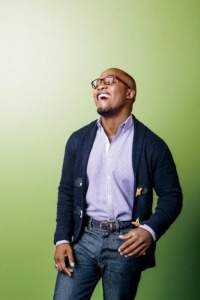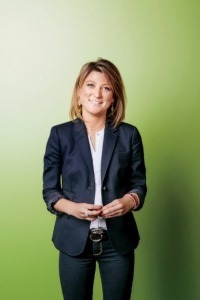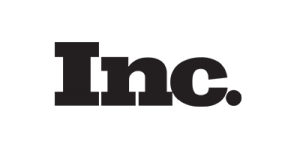NEWS
How did a scrappy tech challenger like Salesforce take on giants like Microsoft and Oracle? A few days at its top-secret boot camp for new hires reveal the old-school ideas behind it all.
My name is Andrew Zinger, and I work at Salesforce! It feels good to say that! Let’s all say that together!”
Really. Zinger. Handsome dude. Late 30s, wearing a silver suit with peg-leg pants, a lavender shirt unbuttoned to the sternum, a brown-and-white shell necklace, and a beard. His swept-back hair contains product. Though it is a Monday afternoon in San Francisco, and Zinger arrived only yesterday from Paris–a commute he bites off twice a month with help from unspecified pharmaceuticals and plenty of beer–he is easily the most animated presence in the room, in command of the podium and the neutral zone in front of it, into which he wanders freely.
“I,” says Zinger coaxingly, and the chorus rises. “Work.” He steps around the podium. “At Salesforce.” He beams. “You can now walk up to people on the street and say that. It gives you a tingly feeling in your body. Like, four-beers-deep tingly. It’s fantastic. So, welcome.”
I don’t work at Salesforce. But I’m attending its weeklong boot camp for new sales staff members. You probably know Salesforce.com–the fast-growing $4 billion upstart that since its founding in 1999 has built a commanding lead in the $20 billion market for customer relationship management, or CRM, software, outselling SAP, Oracle, Microsoft, and IBM. You may not use its product, not yet. It’s expensive. (“Usually three-X the price offered by the competition,” these new hires will be warned. “If you wanted cheap, you shoulda worked at Walmart.”) Salesforce defines roughly one-third of its customers as small businesses, but the software may be more than you need just now for yours–sort of the organizational equivalent of a just-married couple buying a four-bedroom house.
Still, anyone can see right away how cool it is. It gathers, organizes, and disseminates everything there is to know about which products are selling, which customers are buying, and how the sales staff is performing; it integrates with Facebook, Twitter, etc.; it deploys as needed to desktops, laptops, tablets, and smartphones from its home in the cloud.
But here’s the thing: Even the best, most useful product in the world can’t sell itself. You need a sales force to sell Salesforce. Maybe especially to sell Salesforce. That it’s so costly–its full-on CRM product starts at $65 per user per month, and the most expensive version goes for $300–and complex is just the beginning. Salesforce solves problems that some businesses don’t even know they have. (Businesses knew, somewhat, which employees and prospects were performing or not before Salesforce, but by tracking every phone call and contact, Salesforce does it so much better.) It spooks compliance guys, who worry about data security in the cloud. It unsettles IT guys, who fear the bogeyman of legacy integration (and may wonder what happens to their fiefdoms after the integration is complete). It raises the hackles of CFOs: This will pay for itself how?

John Henry Patterson would have understood the challenge perfectly. He was the founder, in 1884, of the National Cash Register company. Before NCR, merchants kept their cash in a drawer. Mostly, that worked fine. Then here came Patterson offering a high-tech substitute. “Not always an easy sell,” Walter Friedman writes in Birth of a Salesman: The Transformation of Selling in America. “Businessmen were reluctant to purchase expensive machines that they had never needed before; they had to be persuaded that the new equipment would result in improved efficiency and saving.”
What Patterson needed, and by necessity invented, was a new breed of professional, that of the modern salesman. Many of the structures and institutions he helped pioneer more than a century ago–in-house sales teams; geographic sales territories; sales conferences; quotas; training academies–we now take for granted. Equally enduring have been the strategies and tactics Patterson’s sales army perfected: the open-ended question, the scripted pitch, the art of defusing objections by acknowledging the customer’s concerns before countering them, trust building. He also knew something about telling stories–though, as we’ll see, on that count, Salesforce may be outdoing the old master.
I’m not exactly sure what I expected when I reported to Salesforce’s boot camp. Something more obviously aligned with a product that lives on the distant edge of the technical universe, perhaps. But much of it felt like Old School Selling 101. Turbocharged with networked tracking tools and gigabytes of data, absolutely, and calibrated to align with 21st-century work habits. But still. Sometimes I thought Patterson could have been our instructor.
“We want salespeople putting points on the board as soon as possible,” says Elay Cohen, a former senior vice president of sales productivity at Salesforce who helped design the current boot-camp curriculum. The clock starts ticking the moment recruits receive their tablets, smartphones, and logins. Their first assignment: 20 hours of at-home video instruction designed to bring them up to speed on software they won’t just be selling–they’ll also be using. They’re tested, of course, and the scores help decide who wins coveted end-of-the-week awards such as Top Gun and Rising Star. (Winners get virtual “badges” that exist only online but confer real-world bragging rights and thereby stoke internal competition.) Total target timeline from first day on payroll to first points on the board: two to three weeks for small-business reps, two to three months for the enterprise reps who sell to big companies.
But the critical black-box initiation into the cult of Salesforce unfolds during the first three days of boot camp. Until recently, new hires were quarantined at an office park in suburban San Mateo. Winning budget approval to move downtown took 18 months, Cohen recalls. The company’s costs are significant: about $2,400 per trainee for the week the group is in residence. But so are the benefits: proximity to high-level execs, who drop in for pep talks and training sessions (founder Marc Benioff did not appear the week I was there, but his aura was everywhere); free run of the City by the Bay after hours; and the glow, the buzz, the grace that imbue Salesforce’s vibrant headquarters in San Francisco’s SoMa district, reminding initiates at every turn that they’re part of something special. One of the first stops on the orientation tour: a window overlooking a dusty pit on Mission Street from which is rising, floor by floor, Salesforce Tower. Scheduled for completion in 2017, it will dwarf the iconic Transamerica Pyramid and assume the mantle of tallest building west of the Mississippi.

Boot camp happens on the fourth-floor “campus” of Salesforce U, and it was planned with input from the Institute of Design at Stanford. It has a brightly painted student lounge that features cozy booths and beanbag chairs, board games, all-day snacks, and a two-compartment drink cooler (the lock comes off the beer side at 4 o’clock). There’s a graffiti wall where students can doodle and sign their names and a photo corral with a built-in iPad stand for snapping selfies.
The lecture hall is tuned for all-day occupancy and alert states of mind. Abundant natural light, big screens everywhere, a killer sound system. Seating is assigned, banquet-style, at tables for eight. The gurus at Stanford preached against too much passive listening; therefore, there are frequent opportunities for discussion in small groups and the occasional appearance by Gino Ramos, Salesforce’s resident dance instructor. (“Again! Last time! Full out! Two more sessions you gotta get through today; two more!”) Zinger does his part by filling every silence with musical stylings from his personal playlist; he favors Little Feat (“anything post-Lowell George is shit”), the Who (“anything from any album”), and the Band (” ’nuff said”).
More than half of the 118 attendees this week are from the United States. The rest (in descending order) flew in from Ireland, Canada, Brazil, Australia, France, Singapore, the U.K., Japan, the Netherlands, Korea, and New Zealand. One-third are women. No newbies; everybody brings at least some sales experience–two years for small-business reps; often two decades or more for enterprise-level account execs. Competition is stiff. HR director Monika Fahlbusch boasts that Salesforce hired merely 4.5 percent of its more than 100,000 applicants last year–a lower acceptance rate than Harvard’s. (Although, as at Harvard, there is a back door for legacies; 60 percent of new hires are referrals.) Many were raided from Salesforce’s rivals. Among them: gray-haired John Houtsma from Denver, who left Oracle after nearly three years “for the story, the momentum,” he tells me, shouting to be heard above “Ain’t No Mountain High Enough” as he and his classmates reassemble after lunch on Monday. “Everything here is just rocking.”
“Welcome to the company,” says Tony Rodoni, senior vice president of commercial and small-business sales. He’s a little older than Zinger, with a lot less hair and the same liking for lavender. “We need you badly.” Rodoni gives everyone the first classroom assignment: “Brainstorm about how you would like your best-referenced customers to describe you.”
There’s an awkward silence at my table as John, Sergio from São Paulo, Rachel from San Francisco, Chase from Toronto, Amy from Boston, and Mike from Cleveland regard one another. Finally someone offers, “If no one else says trusted adviser before it gets to us, I say we start with that.” Nodding all around, then more suggestions: passionate, knowledgeable, invaluable, helpful, visionary. “Storytellers,” says Amy. “Every customer I meet wants to know what the others are doing.”
Trusted adviser?

“That’s one we as salespeople always want to hear, but I’ve never heard it,” Rodoni says in response. “I love that aspiration, but what do you have to do to hear that?” His point: A salesperson’s first duty is to listen and learn, and only then presume to advise. “Eighty-five percent of salespeople don’t slow down enough to really understand their customers’ business,” he says. But “if all you are is responsive and helpful, then all you are is an administrative assistant.” He’s got a little story about his pal the ski instructor who knows that the secret to getting a good tip and repeat business is taking students 10 percent beyond their comfort zone, no more. Customers “do not want someone who will make them inhale all of our vision in one breath,” Rodoni says, delivering the moral. “Don’t be viewed as the most visionary vendor ever.”
Rodoni’s last tip: “Feel the urgency to close the transaction. Get something done.” Granted, Salesforce sells a subscription product–and the quicker the close, the greater the lifetime value of the contract–but it’s good advice for everyone. Don’t just hunt for elephants, Rodoni says. Be like a chicken, pecking in the barnyard all day long, “never full but never hungry.”
“Welcome to Tuesday,” says Zinger, dressed for Day Two in black pinstripes and a peach shirt. “Did everybody have a good night last night? Any G-rated stories anyone wants to share?” As no one offers, Zinger volunteers: He spent the night alone in his hotel room watching movies, two tearjerkers back to back: Schindler’s List and The Piano.
That surprises me. I had Zinger pegged for someone more, I don’t know…reckless? He plays semiprofessional hockey back home in France. He used to be a goalie but switched to defenseman, he told me, because he likes to “hit people”; he’s a metaphorical towel snapper with a talent for teasing (a defining attribute of the sales profession). But he’s a family man, too, married 12 years, has two young sons, and likes movies that make him cry. My bad for misreading him, I suppose, but a light bulb glimmers: Can your customers trust you if they don’t know you?
“You’ve probably started to recognize here at Salesforce that storytelling is very, very important,” Zinger says. “It can be the foundation of things like the corporate pitch and your interactions with your customers and prospects. It’s important to weave your past experiences into your journey here at Salesforce.” Take 15 minutes, Zinger says. Construct a personal timeline. “Tell us who you are.”
“I’m Chantelle,” says a dark-haired young woman, one of several recruits who volunteer to stand and share. “I come from the Toronto office. I’m a sales rep. My story starts out with a dead face.” With that, she has the crowd’s attention. But she’s just getting started. When she was 18, still in high school, Chantelle was found to have an absurdly rare and deadly tumor. It stole the sight in one eye and the hearing in one ear. (“If I don’t see you or hear you, don’t take it personally,” she says.) She was a Make-A-Wish child. But she beat the odds, earned her college degree, traveled the world, became a Make-A-Wish grantor. “And now,” she concludes, “I’m at my dream job.”
Whoa. Who else can tell such a tale? But stories–personal stories, company stories, customer success stories–are powerful tools. They reach customers in ways that detailed offers and explanations can’t. When it comes to overcoming objections–“I don’t want my data in the cloud…I can’t afford this…I need features you don’t offer…replacing my legacy system is too much trouble”–stories can be the most powerful tool a salesperson has. “When faced with objections, we always relate it back to a customer story,” says Greg Gsell, a Salesforce senior marketing manager. “I implore you to go out there and learn customer stories. Listen to the stories. Learn them. Internalize them.”

“OK, three days in, whose eyes are crossing?” Wake up; it’s Jody Kohner time! She’s the Salesforce exec in charge of mapping the competitive landscape. Kohner is pretty and petite, with auburn hair that breaks softly on her shoulders. She wears funky red glasses, green teardrop earrings; paints her lips a lovely shade of rose. And, I assure you, it’s Kohner you want in your foxhole.
“Now here’s why my session rocks!” she hollers. “Here’s why my session is better than every other session you’ve seen or will see. Who in here likes the idea of”–and she slows down now for effect–“early retirement? Anybody, anybody? All right, I have news for you. If you can take out the competition you can make a shit-pot full of money! All right? And that’s what I’m all about. We’re gonna learn how to make a shit-pot full of money by taking out all the competition.”
I have to tell you that to gain access to Kohner’s session, I had to promise I wouldn’t disclose any specific Salesforce battle plans. What I can say she said, more or less, is sell your strength, not the opposition’s weakness. One of the things Salesforce does better than most is cram nearly all its features into a powerful smartphone app. Or, to use some Kohner-ese, “We won’t take out a sign on a side of a bus that says Microsoft Sucks Ass. But we will take out a sign on a bus that says, Hey, run your business from your phone, so that when you’re in there you can say, ‘Hey, what’s Microsoft’s mobile strategy?'”
Part of Microsoft’s mobile strategy seems to involve partnering more closely with Salesforce. Benioff and Microsoft CEO Satya Nadella recently announced a deal to create a Salesforce app for Windows phones. But Kohner doesn’t care. “This is literally a killer partnership,” she insists. “Like, ‘We’re gonna wrap our arms around Microsoft. We’re gonna pretend like we’re a boa constrictor. And we’re gonna suck the life out of them.’ “
Should Microsoft be scared? A Microsoft spokeswoman says the partnership’s focus “is on delivering great benefits to our customers.” Right, but should it be scared? Because right now, I am.
After boot camp broke up and everybody went home, Karine Versace, dean of Salesforce U, sent me a thick electronic packet of survey results. Kohner won speaker of the week, no surprise, scoring a nearly perfect 4.9 out of 5 (“more Jody!!!!!”). Zinger got high marks, too, averaging 4.7 for the five sessions he led. Campers especially liked Zinger’s outfits: 36 percent preferred the one he wore on the first day (“Boot Camp Demi God”), edging out the 34 percent who picked Day Three (faded jeans, white shirt, corduroy blazer with elbow patches–“Too Cool for School”).
Salesforce obsesses over survey feedback, Versace wrote, “not just the numerical score but more importantly the verbal feedback.” So what’s in there? A few trivial complaints (“I must comment in the most nurturing way possible that Mark French did say Etc a lot”). A lot of loud rah-rah (“Frigging awesome!” “Ready to rock!!!!” “I AM PUMPPPEDDDDDDDDDD!”). But buried in the rabble were a handful of quiet but telling remarks that spoke directly to the theme of the week. From one person whose favorite parts of Day Two were the “customer stories” and another who best remembered the “Aha Moment stories and testimonies.” From another for whom the highlight of boot camp was learning “tips on telling the stories. And I loved the account executive/sales two stories!”
That word, again. Every person has a story. Every company has one, too. Leave it to one of the tech-iest companies around to remind you how important yours is.
